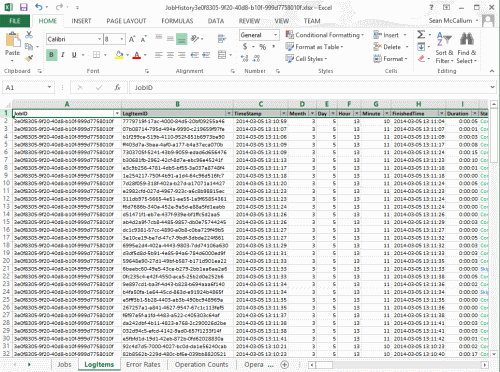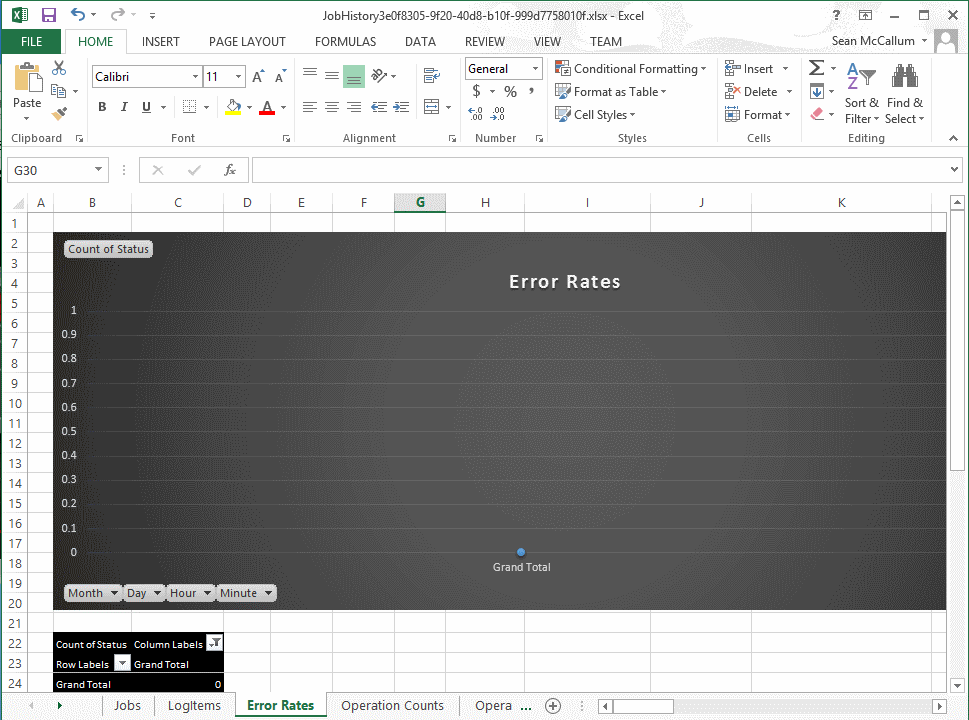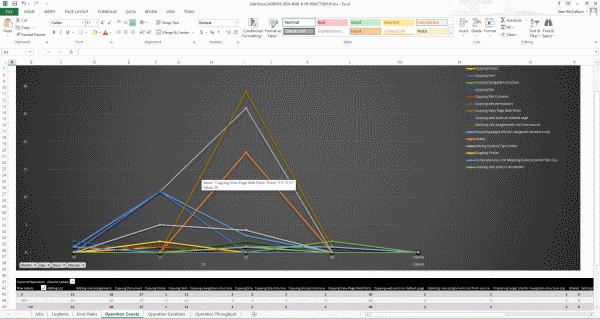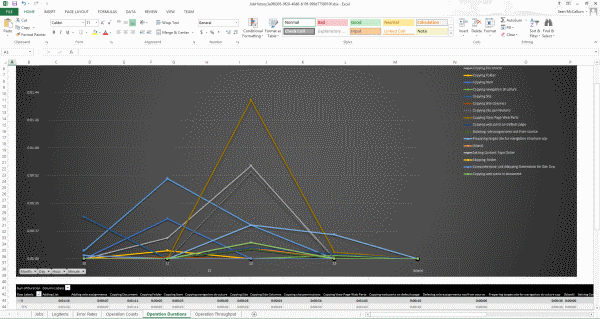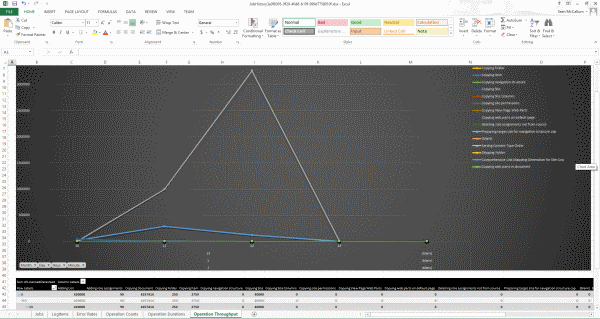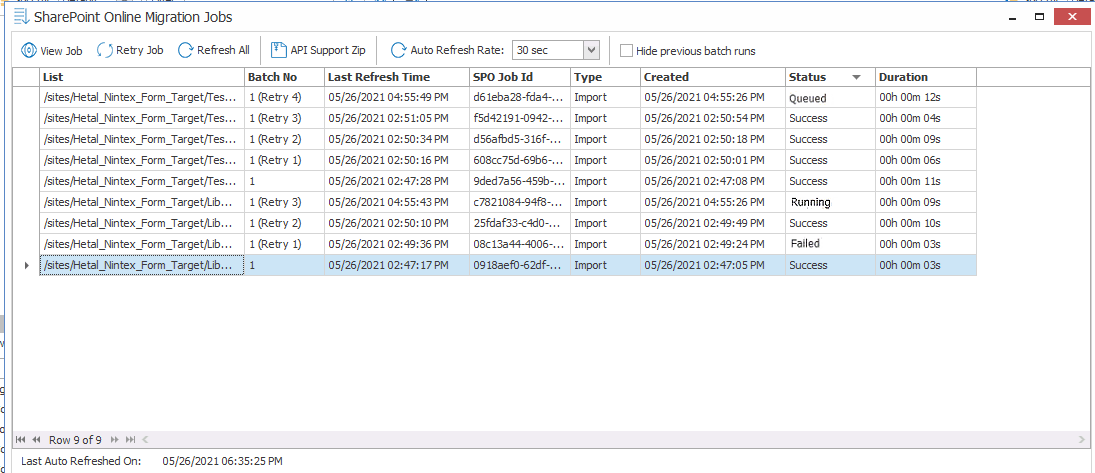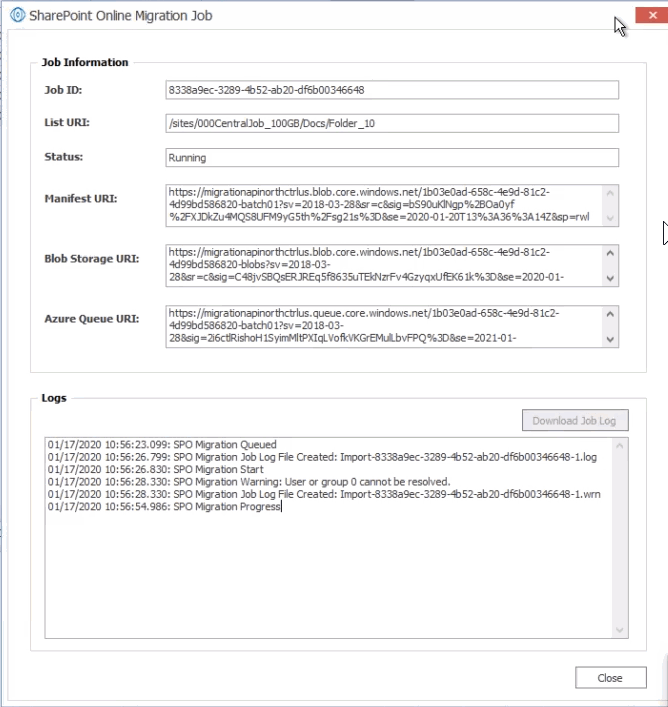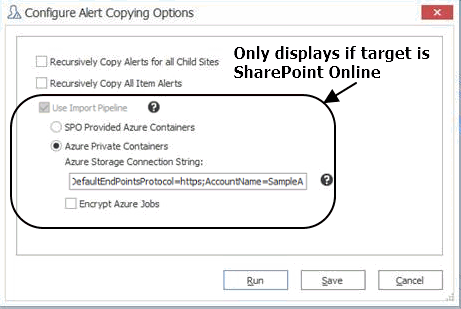Information in Exported Excel Files
|
Navigation: Saving or Running a Migration Job > Exporting Jobs to an Excel File > Information in Exported Excel Files |
When an Excel file is exported from the Metalogix Content Matrix Job List there are a number of page tabs that can be viewed. Each page tab will display a different set of data, and some of these tabs will also display pivot graphs (with pivot tables behind them).
NOTE: The data within all of these Excel tabs (both the tables and the graphs) should only be considered a starting point when looking at your migration data. You can modify the existing graphs through various methods, such as applying filters, changing the data values, etc. You can also take the "raw" data from the LogItems tab and use it to create your own graphs or sets of data as required.
The exported file contains the following tabs:
·Jobs - All of the specific jobs that are included in the export. This includes migration jobs as well as other actions.
·LogItems - All of the operations that have been run by Metalogix Content Matrix and provide all of the logging details that are available in the Log Viewer and Log Item Details windows. Some examples of these operations are: adding lists, adding content types, copying documents, adding users, updating lists, etc.
·Error Rates - A a graph that represents the number of errors and warnings that Metalogix Content Matrix encounters during a migration on a "per minute" basis. The vertical axis will list the number of errors/warnings that are encountered (at the specified time), and the horizontal axis lists the amount of time (displayed in a "per minute" value). The horizontal axis can also be changed to display in month, day, or hour time values as well. Below the graph is a table that provides a different view of the same error/warning breakdown.
·Operation Counts - The number of operations/actions that are run over a period of time. Some examples are: copying sites, copying lists, copying documents, adding SharePoint groups, adding users, copying permissions, etc., and each operation has its own line representation on the graph. The vertical axis lists the number of operations that are running (at the specified time), and the horizontal axis lists the amount of time (this is displayed in a "per minute" value). The horizontal axis can also be changed to display in month, day, or hour time values as well. Below the graph there is a table that provides a different view of the same migration operation data.
·Operation Duration - The total duration of time for each operation/action type against the total migration time. This is potentially the most confusing graph to read in the exported Excel file. The vertical axis lists the total duration time for each action. This is determined by finding the difference between each operation/actions Time Started and Time Finished values, and then adding the totals together for all of that operation/actions of that type that are running. This is then displayed against the horizontal axis which lists the time (displayed in a "per minute" value) for the migration. The horizontal axis can also be changed to display in month, day, or hour time values as well. Below the graph there is a table that will provide a different view of the same migration data.
An example of how to read this graph is: if at minute 25 (of the hour, not the 25 minute of the migration) a large number of small documents are copied and completed (all in the 25th minute), then at minute 25 in the graph there will likely be a spike in the "duration time" for the "Copying Document" operation/action. If each document was copied in 2 seconds, and there were 41 small documents, then the Sum of Duration value would be listed as 82 seconds (or 0:01:22). So the results in the graph would show a spike for the Copying Document operation/action and minute 25, with a value of 0:01:22.
·Operation Throughput The amount of data/throughput (in MB) that is migrated on a "per minute" basis. The vertical axis lists the amount of data that is being pushed through Metalogix Content Matrix for a given operation (at the specified time), and the horizontal axis lists the time (displayed in a "per minute" value) at which that the action was performed. The horizontal axis can also be changed to display in month, day, or hour time values. Below the graph there is a table that will provide a different view of the same throughput data.
Monitoring and Managing SPO Migration Jobs that Use the Import Pipeline
|
Navigation: Saving or Running a Migration Job > Monitoring and Managing SPO Migration Jobs that Use the Import Pipeline |
For migrations to SharePoint Online that use the Import Pipeline, you can monitor the progress of the job, including Microsoft-side processing, via the SharePoint Online Migration Jobs window.
NOTE: This window is used to monitor Objects and Actions Supported Using the Import Pipeline only. Any components of a migration that use CSOM can be monitored via Log Item Details.
To launch the SharePoint Online Migration Jobs window:
1.In the Job List, select the migration job you want to monitor/manage.
2.Right-click and choose Manage SharePoint Online Jobs.
NOTE: This option is available only if the Use Import Pipeline option was selected on the Configure Copy Options - List Content tab, and the window can be open for only one job at a time.
Status Messages
The following are the status messages that display in the SharePoint Online Migration Jobs window.
NOTE: By default, every run of each batch displays in the SharePoint Online Migration Jobs window. If you want to show only the latest status of each batch, check the Hide previous batch runs box.
·Processing - Content Matrix is preparing batches for upload to the Import Pipeline.
·Queued - The batch is awaiting upload to the Import Pipeline.
·Running - The batch has been uploaded to the Import Pipeline and is being processed by Microsoft.
·Success - The batch has been processed successfully.
·Warning - The batch has been processed with one or more issues.
·Failed - Microsoft-side batch processing has failed.
To view batch details:
1.Select the batch whose detail you want to view.
2.In the ribbon menu, click View Job.
NOTE: The identifying URIs (Manifest, Blob Storage, and Azure Queue) are generated by Microsoft and can be used by Support for troubleshooting purposes.
While the job is running, you can view the progress in the Logs section of the window.
EXCEPTION: The progress of a running job cannot be viewed if it was configured using PowerShell.
Once the job has finished processing (or if the job was configured using PowerShell), the [Download Job Log] button becomes enabled, and you can view complete job details.
Job List Upload Duration Column
The column Upload Duration in the Job List displays the time it took for the job to upload via the Import Pipeline. If the migration was done with CSOM only, or the target was SharePoint on premises, the field will be blank.
Retrying Failed Batches
Content Matrix automatically retries a failed batch up to five times by default. (This can be changed via the EnvironmentSettings.xml MaxAzureBatchRetryCount key.) You can also manually retry batches directly from the SharePoint Online Migration Jobs window. Highlight each batch you want to retry and click Retry Job in the ribbon menu.
TIP: You can filter the Status column to display only failed batches.
NOTE You can retry job batches any time before the Azure SAS URL for the job expires (which is 30 days for private containers and a number of days determined by Microsoft for SharePoint Online provided Azure containers). If you want to resubmit a job after this time period, you will need to re-create the migration job. It may still be possible to submit an API Support zip file for troubleshooting between the time that the Azure SAS URL expires and Microsoft destroys a container.
To create an API Support Zip file to send to Quest Support for troubleshooting:
1.Select the batch(es) for which you want to create the zip file. (Note that you can multi-select to create a separate zip file for each batch.)
2.In the ribbon menu, click API Support Zip.
3.Save the zip file(s), and send to Quest Support for troubleshooting.
Note that, by default, a zip file's name is its SPO Job ID. You can, however, rename it.
Copying SharePoint Objects as a Separate Action
Many migration actions can be performed as a separate action after the initial migration is performed.
The following objects and settings can only be copied as a separate, post-migration task:
·SharePoint Email Notification Settings
The following objects and settings can be copied both as part of a full migration or as a separate action:
Copying Alerts as a Post-Migration Task
|
Navigation: Copying SharePoint Objects as a Separate Action > Copying Alerts as a Post-Migration Task |
Metalogix Content Matrix can copy:
·Site, list, and item level alerts to SharePoint on premises targets
·Site and list (but not item) level alerts to SharePoint Online targets

Alerts can be copied only as a separate, post-migration action, using the context (right-click) menu, or by creating a job/batch file.
NOTE: It is recommended that alerts not be migrated within five to ten minutes of the site, list or item being migrated to the target. This is to avoid the risk of having SharePoint send out any unnecessary email alerts regarding any modifications (migrations) that may have been made.
|
For SharePoint on premises targets: When using a Database connection or an Object Model connection through the Local Object Model connection or the Metalogix Extensions Web Service (MEWS), the migrating user (or the Web Service account) must have access to the alerts either in SharePoint or through the database. For SharePoint Online targets: ·Alerts can only be copied using the Import Pipeline, to which your SharePoint Online target environment must be connected. If your scope includes lists not supported by migration using the Import Pipeline, the migration of alerts for the unsupported lists will fail. ·Target objects (site, list, and item) must have the same ID on the target as they do on the source (which means that, as part of the migration, the option to Preserve IDs on items/folders must have been checked on the List Content Options tab). |
|---|
To copy alerts as a post-migration action:
1.In Explorer View, select the source site, list, or item from which you want to copy alerts.
EXCEPTION: The migration of alerts for individual items is not supported for SharePoint Online targets.
2.Select the target object to which you want the alerts copied.
3.Right-click, and choose Copy [Object].
NOTE: Item level alerts can only be copied one at a time.
4.Select the target object to which you want to copy the alerts, right click and choose Paste Site Objects > Alerts.
5.On the Configure Alert Coping Options dialog, check the applicable option(s):
§Recursively Copy Alerts for all Child Sites - This will copy alerts for all sites and lists recursively down through any content, within the scope of the migration. Item level alerts are not included in this option.
§Recursively Copy All Item Alerts - This will copy all item level alerts recursively down through any content, within the scope of the migration.
§If the target is SharePoint Online, the Use Import Pipeline option is checked and grayed out by default, as it is currently the only supported method for migrating alerts to SharePoint Online.
NOTE: If you are using Azure Private Containers and want migration job manifest files encrypted, check the Encrypt Azure Jobs box. (These files are always encrypted for SPO Provided Azure Containers.)
Now you can save or run the action.
Alert Migration Error Handling
When copying alerts Metalogix Content Matrix will check to see if the user already exists on the target. If the user the alert is assigned to does not exist on the target, then Metalogix Content Matrix will try to copy that user to the target before the alert is copied. If for some reason the user cannot be copied to the target an error message will be placed in the log file.
In the case that alerts are not turned on, in the target SharePoint server, Metalogix Content Matrix will give the following error:
Exception thrown: Server was unable to process request. ---> Alerts have been turned off for this virtual server. For assistance, contact your server administrator.
To resolve this issue, activate the alerts feature on the target SharePoint server, and try the migration again.

